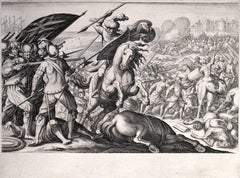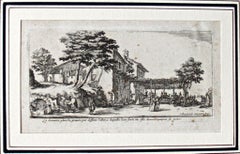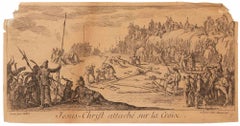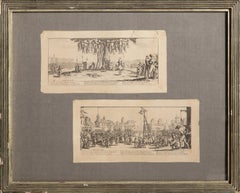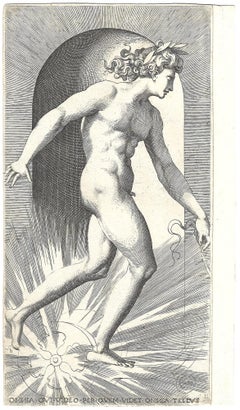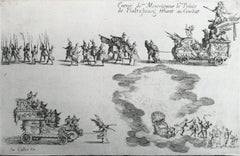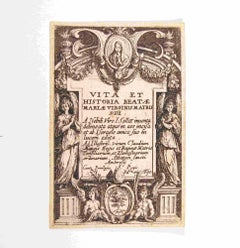Jacques Callot Prints and Multiples
Jacques Callot, at the age of 12 years old, he runs away in Italy with gypsies. Callot returned for the third time to Italy together with an embassy of Duke Henry II to the Holy See. In 1611, Callot entered the workshop of Tempesta, a famous Italian engraver, for three years. In 1614 Callot left Rome for Florence in the service of Cosimo II de Medici. Callot produced drawings and etchings that drew influence from Flemish art and Mannerist works in Roman churches. Callot’s career began in Florence in 1612 when he started work in the Medici court, where he was employed to make pictorial records of entertainments such as fairs and festivals and where he also drew and etched courtiers, beggars and other characters, excelling particularly at caricatures. Returning to his native France in the latter end of his career, Callot’s work became markedly soberer as he documented the horrors of the 30 years of war in his Miseries of War series, which would continue to influence the artistic representation of conflict social injustice into the 19th and 20th Centuries.
17th Century Baroque Jacques Callot Prints and Multiples
Engraving
16th Century Old Masters Jacques Callot Prints and Multiples
Etching
1660s Old Masters Jacques Callot Prints and Multiples
Etching
1610s Old Masters Jacques Callot Prints and Multiples
Etching
17th Century Old Masters Jacques Callot Prints and Multiples
Ink, Laid Paper, Etching
Early 17th Century Baroque Jacques Callot Prints and Multiples
Etching
Early 17th Century Baroque Jacques Callot Prints and Multiples
Etching
1660s Old Masters Jacques Callot Prints and Multiples
Etching
17th Century Realist Jacques Callot Prints and Multiples
Etching
17th Century Realist Jacques Callot Prints and Multiples
Etching
17th Century Realist Jacques Callot Prints and Multiples
Etching
17th Century Realist Jacques Callot Prints and Multiples
Etching
1610s Old Masters Jacques Callot Prints and Multiples
Etching
1610s Old Masters Jacques Callot Prints and Multiples
Etching
1620s Old Masters Jacques Callot Prints and Multiples
Etching
1630s Old Masters Jacques Callot Prints and Multiples
Etching
1630s Old Masters Jacques Callot Prints and Multiples
Etching
1640s Old Masters Jacques Callot Prints and Multiples
Etching
17th Century Old Masters Jacques Callot Prints and Multiples
Laid Paper, Handmade Paper, Engraving
15th Century and Earlier Old Masters Jacques Callot Prints and Multiples
Ink, Handmade Paper, Laid Paper, Woodcut
2010s Baroque Jacques Callot Prints and Multiples
Emulsion, Watercolor, Photographic Paper, Monoprint, Monotype
16th Century Baroque Jacques Callot Prints and Multiples
Etching
Mid-18th Century Old Masters Jacques Callot Prints and Multiples
Handmade Paper, Laid Paper, Etching
17th Century Old Masters Jacques Callot Prints and Multiples
Laid Paper, Etching
16th Century Old Masters Jacques Callot Prints and Multiples
Handmade Paper, Laid Paper, Ink, Woodcut
18th Century Old Masters Jacques Callot Prints and Multiples
Etching
16th Century Old Masters Jacques Callot Prints and Multiples
Ink, Handmade Paper, Laid Paper, Woodcut
20th Century Mannerist Jacques Callot Prints and Multiples
Etching
17th Century Old Masters Jacques Callot Prints and Multiples
Laid Paper, Etching
17th Century Baroque Jacques Callot Prints and Multiples
Paper, Engraving
1630s Old Masters Jacques Callot Prints and Multiples
Etching
1630s Old Masters Jacques Callot Prints and Multiples
Etching
17th Century Old Masters Jacques Callot Prints and Multiples
Etching
1630s Old Masters Jacques Callot Prints and Multiples
Etching
1620s Old Masters Jacques Callot Prints and Multiples
Etching
Jacques Callot prints and multiples for sale on 1stDibs.
Artists Similar to Jacques Callot
- 1stDibs ExpertJanuary 19, 2025Jacques Callot was famous for being an artist. In 1611, Callot entered the workshop of Tempesta, a famous Italian engraver, for three years. In 1614, he left Rome for Florence in the service of Cosimo II de Medici. Callot produced drawings and etchings that drew influence from Flemish art and Mannerist works in Roman churches. His independent career began in Florence in 1612 when he started work in the Medici court, where he was employed to make pictorial records of entertainments such as fairs and festivals and where he also drew and etched courtiers, beggars and other characters, excelling particularly at caricatures. Returning to his native France at the latter end of his career, Callot’s work became markedly soberer as he documented the horrors of the 30 years of war in his Miseries of War series, which would continue to influence the artistic representation of conflict and social injustice into the 19th and 20th centuries. On 1stDibs, find a selection of Jacques Callot art.
